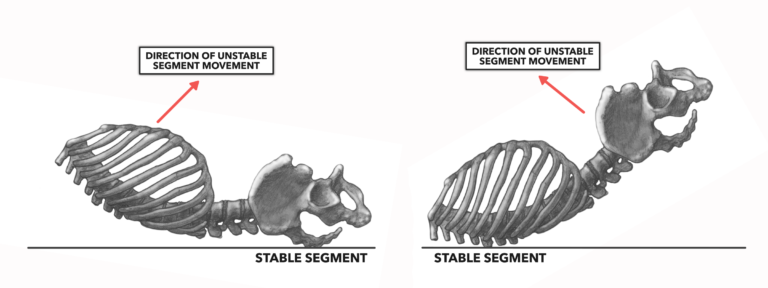There are three layers of posterior vertebral muscles overlaying the vertebral column, and each layer affects vertebral position in postural stability and movement:
Posterior superficial layer – trapezius
Posterior intermediate layer – iliocostalis, longissimus, spinalis (note that these three muscles become more superficial in their lumbar aspects), serratus posterior, external intercostal (grouped here functionally), superior serratus posterior
Posterior deep layer – semispinalis, multifidus, rotatores, intertransversarii, quadratus lumborum, psoas
A coordinated contraction of these muscles creates posterior extension of the cervical vertebrae, flattens the thoracic kyphotic curve, and accentuates the lumbar lordotic curve. We generally just call this “arching” of the back. We can compartmentalize the arching to specific areas of the vertebral column if adequate motor control is present (for some people you have to teach them how to coordinate contractions to produce regional arching).

Figure 1: Arching the back involves contracting the posterior vertebral musculature and relaxing the anterior musculature.
Arching the back involves contracting the posterior vertebral musculature and relaxing the anterior musculature. However, the anterior musculature does not completely relax; it still generates some force to enable positional control within the range of motion. The inverse is true for rounding of the back. (Figure 1)
The anterior musculature is also organized in an approximation of a three-layer structure:
Anterior superficial layer – rectus abdominis, external oblique, transversus thoracis
Anterior intermediate layer – internal oblique
Anterior deep layer – transversus abdominis, internal intercostal (grouped here functionally)
Coordinated contraction of these muscles produces the opposite of arching. “Rounding” of the back results from the forward flexion of the cervical segment, accentuation of the thoracic kyphotic curve, and the flattening of the lumbar lordotic curve.
It is important to recognize that changing which end of the skeleton is most stable (connected to the ground) will change what the arching movement looks like but does not change the physical forces present. The muscles always pull toward center. In reference to creating an arch in the back extension, where the lumbar is most stable and the thoracic is freer to move, the same vertebral muscles are active as in the reverse-hyperextension. However, in the reverse hyper, the lumbar is free, and the thoracic is more stable. (Figure 2)

Figure 2, left: The pelvis/lumbar is most stable, and contraction yields arching and lifting of the chest from the floor, as one would find at the end of a back extension. Right: The thoracic chest is the most stable, and contraction yields arching and lifting of the lumbar and pelvis as one would find in a reverse hyper.
As with arching, when we round the back, the most stable end of the vertebral column dictates how the movement looks. Keeping the lumbar more stable produces movement of the thoracic off the ground. Keeping the thoracic more stable produces movement of the lumbar off the ground (Figure 3).

Figure 3, left: The pelvis/lumbar is most stable. Contraction lifts the chest off the ground, as in a crunch or start of a sit-up. Right: The upper thoracic is the most stable. In this case, contraction lifts the lumbar and pelvis, as in a leg lift.
When considering gross movement of the vertebral column, vis-à-vis arching and rounding, we often only think of the erector spinae as driving arching and the rectus abdominis as driving rounding. However, movement into those positions is complex and requires more than the action of the prime movers. What we frequently consider respiratory muscles, such as inspiratory and expiratory muscles, contribute as well. Inspiratory muscles lift the ribs and contribute to arching, and expiratory muscles pull the ribs down and contribute to rounding. Take a maximally full lung of air and pay attention to what happens to the arch in the back. Push as much air out of the lungs as possible and note the forward rounding of the vertebral column.
The musculature associated with arching and rounding are also critical to the execution of the Valsalva maneuver (trying to exhale against a closed glottis, as when trying to balance air pressure in the ears).
There are additional considerations to be made when we add the hip to the equation, and those will be treated after the presentation of the hip musculature.
ADDITIONAL READING
- Thoracic Muscles, Part 1
- Thoracic Muscles, Part 2
- The Lumbar Vertebrae
- Lumbar Muscles, Part 1
- Lumbar Muscles, Part 2
- Vertebral Curves
- Vertebral Column
To learn more about human movement and the CrossFit methodology, visit CrossFit Training.
Vertebral Arching and Rounding